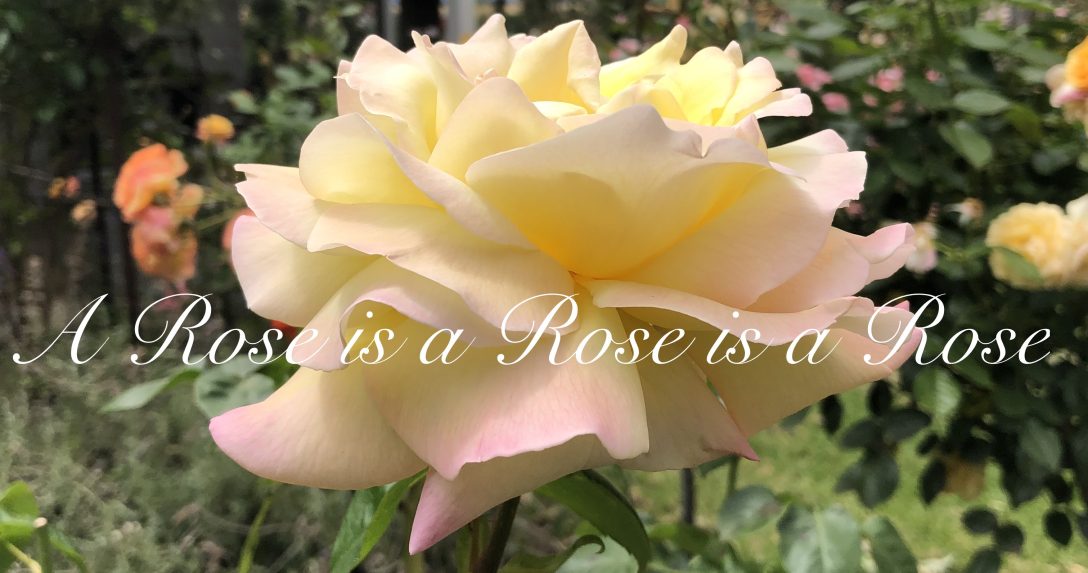Now that I’ve had time to reflect on all I’ve seen in recent travels my favorite Botanical Garden is in Tasmania? The Royal Tasmanian Botanical Gardens ( RTBG ) has a wealth of specialist collections ranging from the Lily Pond, the Japanese Garden, the Historic Wall, and the Gate Keepers Cottage to the Community Food Garden, Succulent and Cacti Garden, Herb Garden, Anniversary Arch, Significant Old Trees, and the Conservatory.

And yet there’s more; the Rose Arbour adjacent to the Fuschia House features a breathtaking display of Pierre de Ronsard roses. The attractive large flowering climbing rose was bred by Marie-Louise Meilland in France in 1976 and introduced as ‘Pierre de Ronsard’ in 1985. The rose is named in honour of Pierre de Ronsard, a famous French Poet in the 16th Century who was known as the “Prince of Poets”.

The quote chosen for the title above refers to the clever design element of conceal and surprise; this Garden has it in spades. Although the diversity is extraordinary in the small space of 34 acres, the Garden is enchanting simply because of this one key element. The unique trees and lush vegetation throughout the garden are incredible, including the pergolas draped with roses, the French Explorers Garden, the Friends Perennial Border and the Subantarctic Plant House (not open when we visited). The Garden works because as you walk around, the perspective alters, and the vistas reveal themselves anew and capture your attention at every turn of the path. The Garden is enticing, giving the visitor an unexpected glimpse of new landscapes, that make you want to continue exploring.

The RTBG started in 1818, only two years after The Royal Botanical Garden Sydney in 1816, the oldest Botanical Garden in Australia. The Garden is situated on the slope of a hill over the Derwent River in Hobart. Numerous paths and walkways give one access to different plant combinations and settings that are picturesque, and unfold as you explore, passing by spectacular trees, including silver birch groves and an ancient cork tree. Volunteer involvement, community and private event spaces, and recycled historical elements are some of the garden design highlights, such as the Conservatory, Anniversary Arch and the Historic Wall.

In 1829, the Governor of Tasmania, George Arthur, decided a heated wall should be constructed through the Garden to protect plants and enable them to grow tropical fruit trees – pineapples were popular at the time. The Wall resembled the heated walls in English Kitchen gardens, with internal coal-fired furnaces that could send hot air and heat through the thick brick and stone. As the climate was so much warmer than the U K, the convict-built Wall was only heated occasionally over the years. The Historical Wall is a backdrop for many perennial plants and trees today. It is the only brick, heated garden wall in the southern hemisphere, and only a few remain around the world.
The garden, historically, is the place where all the senses are exploited. Not just the eye, but the ear- with water, with birds. And there is texture, too, in plants you long to touch.”
Mirabel Osler

“A society grows great when old men plant trees whose shade they know they shall never sit in.”
Greek Proverb

The RTBG Cork Oak Tree – Quercus suber has international heritage value, and is said to be the best tree of this kind in Australia. It was planted in the 1800s and is a magnificent old tree. There are 66 trees from the garden listed with the ‘National Trust of Tasmania’s Significant Tree Register’.

One area of the Garden, that is so pretty is the Lily Pond formed from an old reservoir that has had Nymphe lilies growing for over 100 years. These evidently go dormant in winter but flower all summer in varied shades of red, yellow, pink, apricot and white.

The Lily Pond
The sandstone conservatory is filled with gorgeous indoor foliage and brightly coloured Tuberose Begonias, Canna Lilies, Ferns and masses of perfect indoor plants,










Vistas appear from around every turn, richly planted with an assortment of textured foliage, so the biodiversity is evident everywhere throughout the Garden. Well hidden is this Huon Pine within the woodland area that remarkably is 50 years old, showing how precious these very slow-growing trees are.

“He plants trees to benefit another generation.”
Caecilius Statius





The Japanese Garden
We saw the entirety of this great space and ended up relaxing in the Succulent Restaurant for lunch. The roses stole my heart as they were abundantly flowering specimens that I can only imagine seeing in my own Garden.



Content Di Baker 2023
Title quote by Andrew Crofts
All images Di Baker February 2023
The Header Image is The Gate Keepers Cottage – Di Baker 2023


